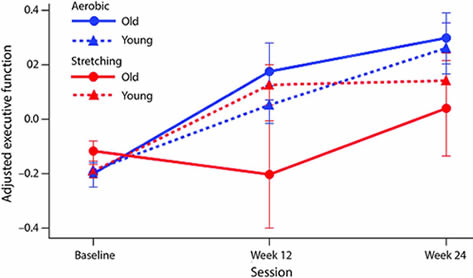Columbia University
Irving Medical Center
Neurological Institute
710 West 168th Street, 3rd floor
(212) 305-1818
TaubCONNECT Research Perspectives:
February 2019
2: » Exercise-linked FNDC5/Irisin Rescues Synaptic Plasticity and Memory Defects in Alzheimerās Models
 |
| Yaakov Stern, PhD |
Effect of Aerobic Exercise on Cognition in Younger Adults: A Randomized Clinical Trial
While animal and human studies indicate cognitive benefits from aerobic exercise across the lifespan, controlled exercise studies in humans have generally been restricted to individuals over the age of 55. Few studies have examined fitness-related improvements in cognition in lower age groups, and it remains unknown whether age might moderate the nature or degree of cognitive benefit. Thus, Taub faculty member Dr. Yaakov Stern, along with Dr. Richard Sloan (Psychiatry) and colleagues from Columbia, conducted a randomized, controlled trial comparing the effects of 6 months of aerobic exercise to a stretching/toning control condition on cognition and brain structure among 132 cognitively normal individuals from age 20 to 67 years.

Figure 3: Change in executive function
Executive function is presented at each study visit by condition in 2 age groups. Age was dichotomized using median split (38 years old). Executive function scores, measure by a summary Z score, are adjusted for age as a continuous variable, IQ, education and baseline executive function.
As published in Neurology and widely covered in the media, their study contributes novel findings on the effects of aerobic exercise on cognition and the brain in several aspects. The key finding was that aerobic exercise increased executive functioning (EF) in adults, ranging from age 20 to 67, but that this effect was moderated by age: for each year of increased age, the improvement in EF was greater. Stern et al. also demonstrated that aerobic exercise was associated with increased cortical thickness in the left caudal middle frontal area, and that this effect did not differ by age. Finally, the investigators included a planned, a priori investigation of APOE as a potential moderator and found that individuals with an APOE Īµ4 allele showed less improvement in EF, though more research on this issue is required. According to Dr. Stern, these findings have āstrong public health implications and allow the recommendation of a feasible, flexible intervention for cognitive and brain health for adults of all ages.ā
Yaakov Stern, PhD
Professor of Neuropsychology (in Neurology, in Psychiatry, in the Gertrude H. Sergievsky Center, and in the Taub Institute)
ys11@cumc.columbia.edu

Ottavio Arancio, MD, PhD
Exercise-linked FNDC5/Irisin Rescues Synaptic Plasticity and Memory Defects in Alzheimerās Models
A study, co-authored by Taub faculty member Dr. Ottavio Arancio, adds to a growing list of endogenous molecules identified through innovative basic research approaches to be important mediators of exercise-induced neuroprotection. The present study, published in Nature Medicine and widely covered in the global media, examined the recently identified, exercise induced myokine Irisin, which is released on cleavage from fibronectin type III domain-containing protein 5 (FNDC5), a transmembrane precursor protein expressed in muscle under the control of peroxisome proliferator-activated receptor-Ī³ coactivator 1Ī± (PGC-1Ī±). FNDC5/irisin stimulates the expression of brain-derived neurotrophic factor (BDNF) in the hippocampus, a brain region centrally involved in learning and memory.
In this study, Dr. Arancio and international colleagues investigated FNDC5/irisin levels in the brain and cerebrospinal fluid (CSF) of patients with AD and in mouse models of AD, and tested the hypothesis that FNDC5/irisin could be a key mediator of the beneficial effects of exercise on synaptic plasticity and memory in AD models. Their results demonstrate that FNDC5/irisin levels are reduced in human AD brains and CSF and in AD mouse models, and that boosting either brain or peripheral FNDC5/irisin levels attenuates synaptic and memory impairments in AD mouse models. Further, the authors show that FNDC5/irisin is a novel mediator of the beneficial effects of exercise on synapse function and memory in AD models. As Dr. Arancio explains, āsince many patients with dementia suffer from other age-related conditions or comorbidities that may prevent them from engaging in regular physical exercise, bolstering brain FNDC5/irisin levels, either pharmacologically or through exercise, may thus constitute a novel therapeutic strategy to protect and/or repair synapse function and prevent cognitive decline in AD.ā
 Extended Data Fig. 9F: Representative images of dendritic spines in hippocampal neurons, as measured by F-actin labeling. |
Ottavio Arancio, MD, PhD
Professor of Pathology and Cell Biology (in the Taub Institute)
oa1@cumc.columbia.edu

